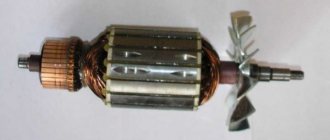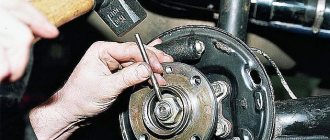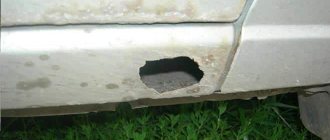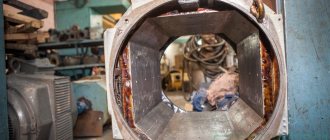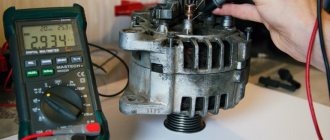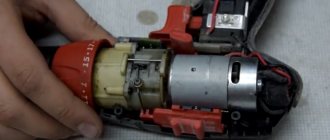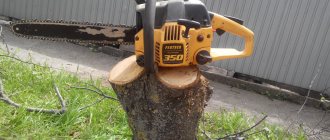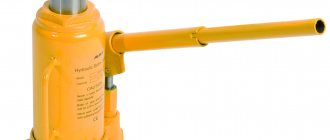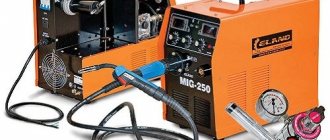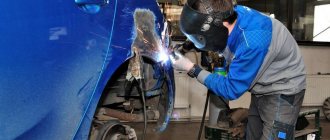Over time, all types of electrical tools can fail. Often the cause of such breakdowns is violations of operating rules or poor quality of tool components. One such tool is an angle grinder or grinder. If the tool does not function, then you should not immediately buy a new one, since such products can be repaired. To repair an angle grinder, you need to know its design, as well as its operating principle.
How does an angle grinder work?
Repairing an angle grinder with your own hands begins with finding the cause of the malfunction. To do this, it is necessary to find out the operating principle and design of the tool. The operating principle of the device is based on the conversion of electrical energy into mechanical energy. Mechanical energy represents rotational movements, which drive the working shaft of the tool with the corresponding attachments.
This means that the grinder consists of two parts: electrical and mechanical. Failure can occur in any node, so it is important to know the structural elements of both parts. The main elements of the grinder include:
- Plastic case.
- The electric motor is two-phase.
- Gearbox.
- Power button.
- Sliding bearings.
- Brush unit.
- Power cord.
- Speed regulator (for some models).
The case is made of impact-resistant plastic. The housing design combines an electrical circuit with mechanics. The motor rotor rotates by applying electric current. Sliding bearings provide rotating movement of the rotor shaft. At the end of the shaft there is a toroidal gear. It drives a flat gear, which is located at an angle of 90 degrees with respect to the shaft. Thus, the work of the angle grinder is carried out. In addition to the two plain bearings on which the rotor shaft rotates, the angle grinder has another bearing assembly. It is located on the working shaft of the mechanical part of the tool.
Typical malfunctions of angle grinders and methods of diagnosis and repair
Do-it-yourself repair of an angle grinder begins with determining the cause of the breakdown. If it is not possible to determine the cause, then you should follow the method of eliminating breakdowns from simple to complex. For self-repair, it is necessary to first identify where the breakdown is located - in the electrical or mechanical part.
Mechanical failures include:
- Gearbox malfunction. The helical gear is mounted on the rotor shaft, so if the motor is running, but there is no rotational movement of the working part, then the reason lies precisely in the gear mechanism. In order to see what happened to the gears, it is enough to disassemble the tool body. The cause of gearbox failure is most often the licking of the teeth of the large shank gear. The reasons for this are varied:
- lack of lubricant;
- heavy loads on the tool;
- low quality of components;
- improper operation.
One way or another, after identifying a malfunction, it should be fixed immediately. This can be done by replacing the faulty gear. Most often, you can find them on sale in a pair with a helical tooth, which is mounted on the shaft. It is recommended to replace two gears in a pair, after which they must be thoroughly lubricated with a special lubricant.
- Bearing failure. A breakdown can be determined by the characteristic sound that will occur when the product is started. This sound will appear as a rustling sound, which indicates bearing wear. The reason for accelerated wear of bearings is dust getting inside the tool. Most often, the bearing located on the working part of the tool behind the plate gear suffers. How to repair a bearing on an angle grinder? First you need to determine if it is intact, then you can clean it from dirt with kerosene, then lubricate it, and put it back in place. If the bearing has worn out, it should be replaced.
- The lock button is faulty. If the locking button malfunctions, there is a problem with installing the appropriate disk for work on the tool. Damage to this button can occur due to wear-out or when starting the angle grinder with the button pressed. To eliminate this breakdown, you will need to disassemble the tool and then replace the product. Many craftsmen, if the button is faulty, jam the working shaft manually using an open-end wrench.
These are the main types of malfunctions of the mechanical part of the tool, the elimination of which does not pose any problems. Now let's pay attention to the more complex part - the electrical one. The following types of breakdowns may occur in the electrical part:
- Damage to the network cable. If the power cable is damaged, the power supply to the power tool is cut off, so the angle grinder will not function. The cable can be damaged for various reasons (squeezing, squeezing, cutting), but it is not difficult to determine the damage. You will need to use a tester to test the wiring. This will require disassembling the tool.
- Control button failure. The design of grinders can have a regular button to start the tool, or they can have a soft start. In a regular button, the contacts most often become oxidized or clogged, which can only be cleaned with sandpaper. In buttons with speed control, the reason is often hidden in damage to the contact plates. The device can be disassembled and then checked for integrity. If a damaged contact plate is found, the starting unit will need to be replaced.
- Problem with the brush mechanism. Brushes are consumables that have a fairly long service life. If your tool is many years old, then it is worth disassembling it and taking a look at the brushes. If they are erased, then they need to be replaced, which is not at all difficult to do. If the brushes are still of sufficient length, then the reason may be in the commutator mechanism, which has obvious signs of oxidation or contamination. It should be cleaned, and then the functionality of the tool should be checked.
- Rotor and stator malfunction. When operating the tool under heavy loads, the stator or rotor winding may burn out. You can determine the malfunction using a multimeter in resistance mode. The best option is to take the complete engine to a repair shop, where the cause of the breakdown will be identified and corrected. Usually the burnt winding is rewound, but it all depends on the scale of the fault.
Prevention and Maintenance
To avoid repairing the grinder, you should periodically diagnose it. First of all, it is important to take care of the mechanical part, which suffers from a lack of lubrication and the occurrence of dust and moisture. There are special lubricants for grinders, both domestic and foreign. Moreover, the lubricant for the gearbox and bearings is different.
The main recommendations for extending the life of an angle grinder are the following:
- Maintain the tool regularly.
- Comply with operating and storage standards.
- Avoid long-term loads, especially for household models.
- Replace worn mechanisms in a timely manner.
From the above it follows that, despite the complex design of such a tool as an angle grinder, extending its service life or making repairs will not be difficult.
Source: instrumentyvdom.ru
Types of breakdowns in grinders
Typical minor damage
In the event of a malfunction, it is first necessary to eliminate elementary breakdowns:
- The grinder does not turn on. The angle grinder suddenly became faulty - it stopped turning on. In this case, you need to check the serviceability of the socket, then the plug and the power cord; perhaps the drive simply does not work due to the fact that no current flows into the product.
- The cable and plug are intact, but the drive does not work. You need to check the start button. It is easier to repair an angle grinder switch by purchasing a new button and replacing it. Since it is rarely repairable - mainly, the plastic switch rod inside breaks. If you want to experiment, you can disassemble it, numbering the contacts, and put everything back in its place so that after assembly there is no short circuit.
- The above parts are unharmed, but the angle grinder does not want to work - which means it’s time to check the brushes. Perhaps it's time to change them in the grinder. Brushes constantly heat up from work, so they wear out quickly and need to be replaced more often than other parts, and in pairs.
Major faults
Having ruled out all minor damage, you need to figure out why the tool does not want to turn on and how to repair it. Most likely, the malfunctions are serious and require additional knowledge. This happens if:
- the body is deformed;
- one of the bearings is jammed;
- the armature or stator does not work;
- the gear teeth of the gearbox are broken or worn out;
- the collector has failed;
- The control electronics sensor shows no signs of life.
If it is determined that the malfunction has occurred in the mechanical part of the angle grinder, then you need to pay attention to the condition of the large gear located on the shaft and the bushings. If the teeth are partially worn out or the shafts become wobbly, they must be replaced immediately.
The most common breakdowns
Grinder malfunctions happen quite often. Everyone who works with this tool knows about this. What goes wrong most often?
The spindle lock button is broken.
Just one awkward press on the spindle lock button while the disk is rotating leads to its breakdown. Sometimes it can be broken if it is used to remove a jammed disk. To prevent this from happening, you need to use an open-end wrench inserted into special holes near the place where the disk is attached.
Broken gear teeth
It mainly occurs when jamming occurs. If you hear a rumble in the gearbox, this is a sign of just such a malfunction. When more than one tooth of a gear is broken, the grinder will not be able to cut the required material.
In order for the tool to continue working, it is necessary to change the gears, all of them, and even the bevel wheel. Before going to the store for spare parts, remember the manufacturer, model and power of the product.
The electric motor does not work.
This type of breakdown occurs with angle grinders that work in places where there is a lot of dust, and when they are given a rest, they are left on the ground. Dust that gets inside spoils the winding. Large loads, especially for a small power angle grinder, result in motor failure.
If the grinder is used for cutting materials that create a lot of dust, then it is recommended to cover the ventilation holes with something.
Bearing fell out
The weakest link, and not only among grinders, are the bearings. High rotation speeds quickly wear out the mechanism. The good news is that changing the bearing is easy. Replacing a worn out bearing on an angle grinder must be done on time to avoid a breakdown that cannot be fixed.
Stator fault
This breakdown is easy to determine when the angle grinder is turned on, but the disk speed is too intense and differs from normal operation - this means that there is a turn short circuit in the stator on the winding. Stator failure is considered the most serious; special skills are required to eliminate it. When you have doubts about your abilities, it is better to turn to professionals so that you don’t have to buy a new tool later.
If the decision to repair it yourself is made, it begins with cutting off the frontal parts of the winding, all remnants are removed. The next step is to make a new winding according to the template. It should be identical in the number of turns, with the same density and from wire of the same thickness as the previous one.
Gearbox
Angler grinders with power less than 1100 W are usually equipped with spur gears.
They are located on the stator. Grinders with higher power have helical gears. Each of the options has a cone-shaped shape; the gearbox rod of the angle grinder intersects with the stator shaft at an angle. Repair of an angle grinder gearbox mainly consists of replacing gears. If a disc gear breaks, it is difficult to replace it because it is very firmly fixed. It is easy to disassemble the gearbox:
- you need to unscrew the nut on its side;
- carefully take the rotor housing in a vice and knock out the gearbox housing with light blows;
- change the position of the clamped rotor and knock out the bearing through a wooden board;
- Unscrew the gear from the shaft.
That's it - the gearbox is disassembled.
Speed controller
Not all models of angle grinders have a speed controller. When an angle grinder is used for cutting, it is, in principle, not needed, but if grinding is carried out, it is simply necessary. If it suddenly stops working, then most likely the board has burned out, which needs to be removed and bought the same one at a power tools store for further replacement.
Repairing an angle grinder yourself is not always possible. If suddenly something does not work out or everything is not clear, it is better to contact the service center.
REPAIRING A GRINDER WITH YOUR HANDS VIDEO
YAP19 › Blog › Repair of a grinder (breakage of vibration supports). YAP19 last online 20 hours ago. Winter.frost. You can’t really “sit” in the garage, and in order not to waste time in vain, I decided to repair the Smolensky sander for a long time. Repair of the belt grinder Sturm BS Boris Tarasov 3rd year. The belt sander has waited for its place Added: 3 years. lerich by 3 years old. Repair of an eccentric (orbital) sander. How to maintain a Festool sander How to maintain Festool ETS EQ Tool repair Repair of a sander, replacement of the sole Repair of a sander How to repair an orbital.
Grinder - rules for working with electric grinding tools
An angle grinder is called a “grinder” only in the repair spaces of the former USSR for a prosaic reason - it was produced individually in the city of Plovdiv. A high-speed cutting wheel is an indispensable assistant when processing the most durable metal, when installing siding on the ceiling, when cutting reinforcement, sheets, profiles and many other repair operations. No less popular are the grinding capabilities of grinders - they allow you to eliminate burrs and roughness from both metal and stone or marble.
Over the past 40 years, the range of grinders has grown enormously, but the rules for handling this convenient and multifunctional tool have not changed much. Moreover, repairs are often prevented by following simple operational recommendations :
Bulgarian and its operation
An angle grinder is called an angle grinder. The name of the instrument is due to the fact that it was produced in Plovdiv. It is intended for performing work on grinding or trimming hard material:
Does a good job of sharpening tools.
A grinder is a very necessary tool these days, so almost everyone has one.
There are grinding machines of different power: from 500 W to 2500, depending on the thickness of the wheel - from 115 mm to 230 mm. The most popular ones in use are angle grinders with a power of 1.2 W, and the most used disc is 125 mm thick.
Every year the choice for this construction power tool becomes wider, but the operating rules remain almost unchanged. And even if you always adhere to them, sooner or later malfunctions arise in the mechanism, which you can try to fix yourself by collecting everything you need to repair the angle grinder.
Repairing a tool relies on knowledge of its design and common sense
Any angle grinder consists of the following components and mechanisms, the location and condition of which should be confidently understood:
- Anchor. The internal part of an electric motor that rotates when the tool is operated at a controlled angular speed. The higher the rotation speed of the armature, the greater the power of the grinder. Unlike its marine “brother,” an anchor in electrical equipment should not brake under any circumstances;
- The collector is a separate place (platform) on the armature where the power and control windings are routed. Already from the name it is clear - here the signals to the engine and the control unit are switched. The collector is clearly visible after removing the housing - the contact plates are polished and have significant dimensions;
- Electric brushes are a special type of conductors for supplying current from the power cable to the collector. In working condition, they spark weakly and evenly, their glow is visible through the ventilation holes in the body of the angle grinder;
- The gearbox is a special mechanical device at the front of the grinder. Designed to transfer the mechanical energy of a rotating armature to a rotating disk. In this case, both the rotation speed of the working disk and the power it develops are subject to adjustment;
- The stator is the part of the electric motor of the angle grinder in which the armature (rotor) rotates. The most complex part of the tool, due to the strict precision of the windings pressed into it. Rewinding the stator of an angle grinder with your own hands is a risky procedure; it is better to entrust it to a specialized workshop;
- Handles-holders, power cable with plug and housing with control and regulating devices.
An extremely desirable assistant in repairs would be layout and electrical diagrams, as well as detailed instructions specifically for the model of angle grinder that needs to be repaired. Unfortunately, many manufacturers do not burden their devices with such frills. In this case, you can get the necessary information from a know-it-all on the Internet and not repair the angle grinder yourself, hoping “maybe, everything is simple,” of course, unless you want to buy a new tool based on the results of the repair procedures...
Where is the spindle lock button located on the angle grinder and how necessary is it?
The latch is a spring-loaded metal rod , on one end of which the button body is placed, and the other can fit into one of the holes in the body of the gearbox bevel gear. From the description it follows that the button should be located on the gearbox housing, not far from the spindle shaft .
Locking button on the body of the angle grinder Interskol. Photo VseInstruments.ru
By pressing the button and rotating the shaft, the locking rod gets into one of the holes on the gear. Holding the button in this position with one hand, unscrew/tighten the flat threaded washer that clamps the working tool with the other hand. The stationary spindle makes this operation possible.
Do-it-yourself grinder repair - we eliminate typical malfunctions
The main principle in the repair of any electrical equipment is the postulate “move from simple to complex.”
Whether it’s a household electric chuck or a turbine at a hydroelectric power station, the repair sequence should eliminate basic faults first. Electricity and electronics are not called “the two sciences of contacts” for nothing. Typical malfunctions of grinders, coupled with methods for eliminating them, are as follows:
- The instrument suddenly stopped showing signs of life. With a 90% probability we can conclude that the current from the outlet does not reach the electric brushes. That is, the problem lies either in the power plug, or in the wire itself, or in the “Start” button mechanism. It is enough to disassemble the case and “ring” the cable with an ordinary tester for the presence of breaks - very often it is enough to replace the wire, and the angle grinder will work like new;
- The wire and plug are guaranteed to be intact, but the tool is still immobilized? It is necessary to disassemble the trigger mechanism, and it is advisable to mark the contacts to be removed - if they are subsequently connected incorrectly, the winding may burn out or the armature may jam. You can replace the start button with any similar one; the operating parameters are clearly marked on it;
- The “Start” button and the power cord are in working order, but the grinder doesn’t want to work? It's time to start working on the net holders. Very often, it is enough to clean the contact plates on the commutator, and the long-awaited spark and smooth hum of the mechanism appears. If it is not there, then it is necessary to replace the brushes. The lifespan of these devices is usually limited to several years. A number of models of grinders are produced with solder connections for electric brushes; new ones must be soldered and installed as a set; their partial replacement is not allowed;
- After replacement, carefully inspect the old electric brushes - if they show uneven wear, this is a clear sign that the center of gravity of the tool or its moving internal part has shifted. It is better to contact a specialized company for the repair of complex electrical equipment - it is unlikely that you will be able to adjust the balance yourself without experience.
Replacing brushes is the “top of the first level” when self-correcting faults in electric grinders. You can continue to describe repair recommendations on how to disassemble the gearbox of an angle grinder, rewind its winding, or reconfigure the electronics. But serious breakdowns require a serious approach to work. If you have never seen this gearbox, how will you be able to fix it? The chance of turning on the grinder depends on your common sense - saving on professional repairs will result in the loss of the entire tool.
How to repair, replace the latch
Before you begin repairing the retainer, you should search for any defects. To do this, you need to disassemble the grinder gearbox. Clean the gearbox from old grease, after eliminating the defect, replace it with a new one.
In this case, you can drill the hole to a larger diameter (taking into account the overlap of the destroyed parts of the body) and press a bushing (preferably brass) into it. The inner diameter of the bushing must match the repair kit used.
Some craftsmen solve the problem of a broken latch with a destroyed body using their own methods. The video shows one of these methods.
Here, after drilling a hole, the author cuts a thread in it and uses a bolt of a certain length that is screwed into it as a fixing element. Under normal operating conditions, a plug is screwed into the threaded hole to prevent lubricant from leaking out and foreign particles from entering the gearbox.
The disadvantage of this design is that it is difficult to feel the end of the bolt entering the groove on the gear body. It is possible that it could be confused with simple gear compression. The spring-loaded rod in the repair kit provides greater assurance that the retainer will be installed correctly. The main advantage is the ease of repair work.
How to do something yourself, with your own hands. home handyman website
How to choose and use a vibrating grinder
The kitchen floor, made of natural oak parquet, once varnished on an acrylic base, has shown scuffs, scratches and other imperfections over the previous years of active use. The time has come for renovation and repair. I decided to remove the old floor covering using a hand sander. The area is small - about 8m2. I had some experience in operating an old surface grinder, but it had already worn out significantly. For the upcoming work, I decided to purchase a new, modern and more powerful tool. I had to collect and study the necessary information, go to stores and exhibitions, and hold instruments from various manufacturers in the palm of my hand. I decided on the Kress 300 RSE.
PURPOSE OF THE GRINDER
An vibration grinder (also called a surface grinder) is designed for dry grinding of a flat surface. Using abrasive sheets of different grain sizes, you can sand wood, metal, plaster and putty, process
products made of plastic, stone, composite materials, remove old paint, varnish coatings, rust, “renew” wood surfaces exposed to precipitation and humidity. It is used for final finishing. Main areas of use: woodworking, furniture repair and manufacturing, repair and finishing work, body work when performing car repairs. There are also descriptions of methods for unusual use of the abilities of this tool, such as felting felt and making various mixtures (to vibrate the body of a mortar container).
PRINCIPLE OF OPERATION OF THE GRINDING MACHINE
Vibration of the grinding plate of the device is achieved by rotating an eccentric connecting rod mounted on the motor shaft. Vibratory grinders have a rectangular sole, which makes reciprocating movements with a small amplitude, but at a very high speed.
The power consumption of a handheld vibratory sander is usually between 150 and 600 watts.
One of the more important features of vibrating grinders is the amplitude of movement of the sole: the simpler it is, the faster it is, but the rougher the surface is processed. You should pay attention to all these characteristics when choosing a car. Devices with an oscillation amplitude of 1.5-3.0 mm are used for fine grinding, and with an amplitude of 3.0-4.5 mm - for quick and rough processing.
Probably the models are equipped with devices for adjusting the number of strokes at idle speed from 10 to 25 thousand rpm. This allows you to select an operating mode taking into account the characteristics of the surfaces being processed and expands the versatility of the tool.
Features of the tool and its choice
Grinding machines are designed for grinding various surfaces. flat, wide, uneven and removing old coating in the material. Before you start choosing a band saw, you should be familiar with some of its features, which are very important when choosing a tool.
Web page width . The quality of the work depends on this, since the grain size and the correct width affect the final result of the work. The width of the belt always depends on the width of the machine sole.
Power . The performance of the machine will depend on this indicator, so you need to choose it taking into account the purpose of the tool. If it is intended for household needs, then you can choose the simplest tape machine, but for production you need a powerful tool.
Belt rotation speed. this figure can provide good performance
Speed control. The function allows you to adjust the speed, allows you to process parts more accurately, and also work with heat-sensitive material.
Smooth start The machine significantly reduces its wear.
The cost of the tool will depend on its technical capabilities, as well as on the manufacturers and quality of materials used in assembling the tool.
The machine often comes with a dust collector that connects to the tool and collects shavings and wood dust.
This wood surface tool is an indispensable tool as it greatly simplifies the process of sanding many types of surfaces and guarantees a high-quality end result.
Source
Repair of the SKIL 7366 vibration sander. It starts, but turns weakly and hums.
Repair
vibration grinder Skil 7366. Reason: axial play of the rotor (armature) due to a jammed bearing.
Wood dust that is not removed in time can spontaneously ignite under unfavorable operating conditions—overheating and tool malfunction.
Use personal protective equipment when working with the grinder. Goggles, a respirator, comfortable clothing and shoes reduce the risk of injury.
The sanding sheets are secured to the surface of the base plate using clamping arms or Velcro tape.
Some machines successfully combine both methods of securing sanding sheets.
It is necessary to choose the correct sanding sheets that match the model of the grinding machine. You should check the location of the holes on the sheet and select the correct grain size. Manufacturers of sanding machines also offer devices for cutting holes in sanding paper (in the form of a template and a punch).
Special abrasive cloths and sprayed meshes can also serve as consumables. With their help, you can structure wood, clean metal from rust, and polish putty surfaces. When using sanding nets with a large mesh when processing putty surfaces, it is easier to remove dust from the surface being treated using a vacuum cleaner.
High-quality repair of a sander with your own hands
In modern finishing work, various construction tools are used. Grinding machines are no exception.
Grinding machine device.
Any tool can become damaged due to frequent use. And in order to repair a grinder with your own hands, you need to have an idea of its components and possible causes of failure. Since the angle grinder is the most popular, subsequent repairs will be considered using its example.
General view of the grinder.
In terms of design and external characteristics, such a machine is an angle grinder, as it consists of the same parts.
The grinder consists of:
- protective casing;
- ventilation hole;
- push-button switch;
- side handle;
- spindle lock.
Repairing a grinder should be done carefully and slowly, since the consequences of repairing power and electronic units can turn a minor breakdown into the unusability of the device.
You won't need many tools to repair a sander:
Components of the device mechanism
A bearing caked with grease is a common cause of grinder breakdowns.
The machine has internal components and mechanisms, the structure of which also needs to be understood;
This is the element of the electric motor in which the armature moves. It is the most complex element, since the windings in it must be pressed in with strict precision. It is not recommended to rewind the stator yourself; it is better to entrust this work to a specialist. When making repairs, it is recommended to rely on the layout and electrical diagrams and have on hand the instructions that came with this particular model of grinding machine. But many models do not come with such instructions; in this case, it is wiser not to carry out repairs yourself, but to seek help from a service center.
Electrical equipment for angle grinders
Over several decades, the external parameters of the angle grinder have remained almost unchanged, with the exception of improved models that use a battery as a battery. The basis of the tool is a housing with a built-in asynchronous motor and gearbox, and a handle with a protective housing is screwed on.
The power tool can be used with cutting and sanding discs, and there are also discs with sanding pads for sanding. Like all tools, a sander can fail to work, but most often it’s not that difficult to fix the problem. This may require disassembling the case and minor repairs of parts. However, it is necessary to understand the structure of the angle grinder, the circuit of which contains the following elements:
- Collector;
- Anchor;
- Brushes;
- Gearbox;
- Stator;
- Handle holder;
- Plug and power cord.
The performance of all elements is very important for the normal functioning of the entire system. If any part fails, the grinder becomes a useless tool. In order for the grinder disc to rotate, the armature must rotate and drive the gearbox, and the faster the armature rotates, the greater the rotation speed of the disc. The collector is a unique part in the form of a platform to which contacts of power and control electrical components lead. The commutator receives voltage from the brushes, and in a further process, electrical energy is converted into mechanical energy.
The area polished with brushes can be seen when disassembling the case. Through the power cable, current flows to the brushes, which transmit voltage to the commutator. Most often, brushes make themselves known by glowing, and depending on the glow, the degree of performance of the brushes or armature can be determined. An equally important part is the gearbox. The main task of the gearbox is to transmit motion from the armature to the working shaft, on which a disk or other device is installed. The power of a power tool depends on the design of the gearbox, since this parameter is determined by the number of teeth of the main gear of the gearbox.
The stator is considered a very complex technical component of the electrical circuit of an angle grinder. The stator contains a winding that determines the rotation of the rotor. If a winding fails, rewinding it independently is rarely done and even less often can be successful. In case of such malfunctions, there is no need to take risks - to troubleshoot problems, you need to contact experienced specialists.
Grinder repair: recommendations
When repairing any equipment, consistency must be observed. Simple faults are:
The device suddenly stopped working.
The first thing to check is the electric brushes, since there is a possibility that they are not receiving current from the power supply.
To replace the bearing, the horseshoe retainer must be removed.
Specifically, the problem may lie in the power plug or in the wire itself, and the “Start” button may not work. To fix the problem, the housing is disassembled and the wiring is tested using a break tester. In frequent cases, the problem is in the wiring, and after replacing it, the grinder will start working again;
If such a problem occurs, it is recommended to contact a specialized service department, since it is impossible to adjust the balance with your own hands. Repairing brushes is a minor repair when troubleshooting, but more serious damage is best left to specialists.
Additional recommendations
It is also recommended to follow basic operating rules to prevent malfunctions:
- it is forbidden to remove the casing over the abrasive wheel unless necessary, and if this is unavoidable, then the tool must not be allowed to touch;
- During operation of the grinder, sparks are generated, it is necessary to avoid their contact with wires and similar flammable materials;
- It is important to firmly secure the part being sanded.
the machine must be held firmly in your hands; if the disk jams, the device may break out of your hands, and therefore the machine may be seriously damaged and result in injury;
In addition, you should not put pressure on parts to speed up work. Abrasive wheels work on the principle of removing the top layer, and therefore do not require pressure.
Source: mydwg.ru

